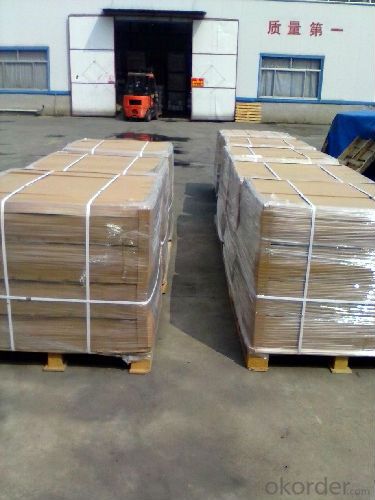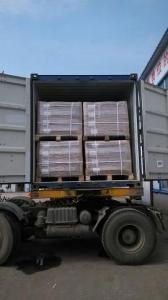C Glass Fiber Woven Fabrics
- Loading Port:
- China Main Port
- Payment Terms:
- TT or LC
- Min Order Qty:
- 17600 kg
- Supply Capability:
- 176000Kg Per Month kg/month
OKorder Service Pledge
OKorder Financial Service
You Might Also Like
1.Brief Introduction
C Glass fabrics are bidirectional fabric made by interweaving direct rovings.
C Glass fabrics are compatible with unsaturated polyester, vinyl ester, epoxy and phenolic resins.
C Glass fabrics are a high performance reinforcement widely used in hand lay up and robot processes to manufacture boats, vessels, plane and automotive parts, furniture and sports facilities.
2.Product Features
Warp and weft rovings aligned in a parallel and flat manner, resulting in uniform tension
Densely aligned fibers, resulting in high dimensional stability and making handling easy
Good moldability, fast and complete wet out in resins, resulting in high productivity
Good mechanical properties and high strength of parts
3.Product Specifications
Property | Area Weight | Moisture Content | Size Content | Width |
(%) | (%) | (%) | (mm) | |
Test Method | IS03374 | ISO3344 | ISO1887 | |
CWR200 | ±7.5 | ≤0.15 | 0.4-0.8 | 20-3000 |
CWR270 | ||||
CWR300 | ||||
CWR360 | ||||
CWR400 | ||||
CWR500 | ||||
CWR600 | ||||
CWR800 |
Special specification can be produce according to customer requirements.

4.FAQ
Packaging:
Each woven roving is wound onto a paper tube which has an inside diameter of 76mm and the mat roll has a diameter of 220mm. The woven roving roll is wrapped up with plastic film,and then packed in a cardboard box or wrapped up with kraft paper. The rolls can be horizontally placed. For transportation, the rolls can be loaded into a cantainer directly or on pallets.
Storage:
Unless otherwise specified,It should be stored in a dry, cool and rain-proof area. It is recommended that the room temperature and humidity should be always maintained at 15℃~35℃ and 35%~65% respectively.
- Q:What are the different lamination options available for fiberglass fabric?
- The different lamination options available for fiberglass fabric include resin impregnation, film lamination, and adhesive lamination.
- Q:Can fiberglass fabrics be used for reinforcement in architectural structures?
- Indeed, architectural structures can benefit from the use of fiberglass fabrics for reinforcement. Fiberglass, known for its strength and lightweight nature, possesses exceptional resistance to corrosion and high tensile strength, rendering it an ideal choice for reinforcing various architectural elements. The construction industry often employs fiberglass to strengthen concrete structures like walls, beams, and columns. By embedding fiberglass fabrics into concrete, its durability and strength increase, offering additional support and minimizing the risk of cracks or structural failure. Moreover, fiberglass fabrics display flexibility, allowing easy molding and shaping to accommodate diverse architectural designs and structures. Ultimately, fiberglass fabrics prove to be a versatile and dependable option for reinforcing architectural structures.
- Q:Can fiberglass fabric be used for insulation in cryogenic systems?
- Yes, fiberglass fabric can be used for insulation in cryogenic systems.
- Q:Can fiberglass fabric be used for gloves?
- Yes, fiberglass fabric can be used for gloves. Fiberglass fabric is known for its high strength and heat resistance properties, making it suitable for various industrial applications, including gloves. These gloves are commonly used in industries such as manufacturing, automotive, and construction, where workers require protection against sharp objects, hot surfaces, and chemicals. The fiberglass fabric used in gloves is typically coated with a layer of heat-resistant material or lined with a heat-resistant material to enhance its protective properties and provide comfort to the wearer. However, it is important to note that fiberglass fabric can cause skin irritation or allergies for some individuals, so proper precautions should be taken, such as wearing a liner glove underneath or using gloves made with other materials, if necessary.
- Q:How is fiberglass fabric used in the military industry?
- Due to its exceptional properties, fiberglass fabric is widely used in the military industry. One of its primary applications is in protective equipment and armor, such as bulletproof vests, helmets, and body armor. This lightweight yet strong material provides excellent ballistic resistance to soldiers. Fiberglass fabric also plays a crucial role in reinforcing and strengthening military vehicles and aircraft. It is commonly used to reinforce armored vehicles like tanks and personnel carriers, making them more resistant to explosions and other hostile actions. Its high tensile strength and durability make it an ideal choice for this purpose. In addition, fiberglass fabric is utilized in the construction of military tents and shelters. Its lightweight nature, durability, and resistance to extreme weather conditions ensure the protection and comfort of military personnel in the field. Moreover, fiberglass fabric is employed in manufacturing communication and radar equipment enclosures. Its electromagnetic transparency allows for efficient signal transmission and reception without compromising the safety or functionality of the equipment. This is particularly crucial in military operations where reliable and secure communication is of utmost importance. In summary, fiberglass fabric is extensively used in the military industry for various purposes, including protective equipment, vehicle reinforcement, tent construction, and communication equipment enclosures. Its unique properties enhance the safety, durability, and effectiveness of military personnel and equipment in combat situations.
- Q:How is fiberglass fabric used in the production of heat shields?
- Fiberglass fabric is commonly used in the production of heat shields due to its excellent thermal insulation properties. It is capable of withstanding high temperatures and helps protect surrounding components or surfaces from heat damage. The fabric is often layered or combined with other materials to create a heat-resistant barrier, which can be used in various applications such as automotive, aerospace, and industrial settings.
- Q:Is fiberglass fabric resistant to chemicals in oil and gas industry?
- Yes, fiberglass fabric is generally resistant to chemicals in the oil and gas industry. It is known for its excellent chemical resistance properties, making it a suitable material for various applications in this industry.
- Q:How much resin does 1 square meter 02 fiberglass cloth need to consume?
- Should be less than 200 grams of resin, depending on your craft and glass cloth varieties, hand paste process in general
- Q:How is fiberglass fabric different from other types of fabric?
- Fiberglass fabric is different from other types of fabric primarily due to its composition and unique properties. Unlike natural fabrics such as cotton or silk, fiberglass fabric is made from thin strands of glass that are woven together to form a textile material. This unique composition gives fiberglass fabric several distinct advantages over other types of fabric. Firstly, fiberglass fabric is known for its exceptional strength and durability. The glass fibers used in its production are incredibly strong and resistant to tearing, stretching, and general wear and tear. This makes fiberglass fabric ideal for applications that require a high level of durability, such as in the construction industry or for industrial purposes. Secondly, fiberglass fabric is highly heat-resistant. The glass fibers used in its production have a high melting point, which allows the fabric to withstand extreme temperatures without deteriorating or catching fire. This property makes fiberglass fabric suitable for use in applications where heat resistance is crucial, such as in fire-resistant clothing or insulation materials. Additionally, fiberglass fabric has excellent chemical resistance. It is not easily affected by most chemicals, including acids, alkalis, and solvents. This makes fiberglass fabric a preferred choice in industries where exposure to corrosive substances is common, such as chemical processing or automotive manufacturing. Moreover, fiberglass fabric is known for its lightweight nature. Despite its strength and durability, fiberglass fabric is relatively light, making it easier to handle and transport compared to other heavy-duty fabrics. This lightweight property is particularly advantageous in applications where weight is a concern, such as in aerospace or automotive industries. Lastly, fiberglass fabric has excellent insulation properties. It is a poor conductor of heat and electricity, making it an effective insulator. This insulation capability is beneficial in various applications, including thermal insulation for buildings, electrical insulation for wiring, or even in the production of protective clothing for workers in extreme environments. In conclusion, fiberglass fabric stands out from other types of fabric due to its exceptional strength, heat resistance, chemical resistance, lightweight nature, and insulation properties. Its unique composition and advantageous properties make it a versatile and preferred choice in various industries and applications.
- Q:Can fiberglass fabrics be used for reinforcement in composites?
- Composites utilize fiberglass fabrics for reinforcement purposes. These fabrics consist of woven or knitted strands of glass fibers, renowned for their remarkable tensile strength and stiffness. They are frequently employed as reinforcing materials during the manufacturing processes of composites. Composites refer to materials created by amalgamating two or more dissimilar materials, resulting in a novel material with enhanced properties. Fiberglass fabrics are typically combined with a matrix material, like epoxy resin, to form a robust and lightweight composite structure. The utilization of fiberglass fabrics as reinforcement in composites offers several benefits. Firstly, they exhibit exceptional durability and mechanical properties, including high tensile strength and stiffness. Consequently, they are suitable for applications necessitating a high strength-to-weight ratio, such as the aerospace, automotive, and marine industries. Furthermore, fiberglass fabrics possess the capability to be easily molded into intricate shapes, making them versatile for various purposes. They also exhibit resistance to corrosion, in addition to possessing commendable thermal and electrical insulation properties. Moreover, fiberglass fabrics can be customized to meet specific design requirements by adjusting the orientation of the fibers, fabric weight, and resin system. This allows for the optimization of strength, stiffness, and other mechanical properties, depending on the intended application. In conclusion, fiberglass fabrics are widely used as reinforcement in composites due to their exceptional strength, lightweight nature, durability, and versatility. They provide numerous advantages and are an indispensable component in the manufacturing of sturdy and lightweight composite structures across various industries.
1. Manufacturer Overview |
|
|---|---|
| Location | |
| Year Established | |
| Annual Output Value | |
| Main Markets | |
| Company Certifications | |
2. Manufacturer Certificates |
|
|---|---|
| a) Certification Name | |
| Range | |
| Reference | |
| Validity Period | |
3. Manufacturer Capability |
|
|---|---|
| a)Trade Capacity | |
| Nearest Port | |
| Export Percentage | |
| No.of Employees in Trade Department | |
| Language Spoken: | |
| b)Factory Information | |
| Factory Size: | |
| No. of Production Lines | |
| Contract Manufacturing | |
| Product Price Range | |
Send your message to us
C Glass Fiber Woven Fabrics
- Loading Port:
- China Main Port
- Payment Terms:
- TT or LC
- Min Order Qty:
- 17600 kg
- Supply Capability:
- 176000Kg Per Month kg/month
OKorder Service Pledge
OKorder Financial Service
Similar products
New products
Hot products
Hot Searches
Related keywords





























